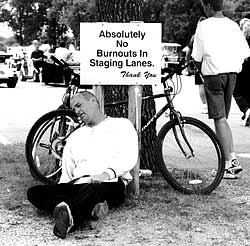|

Thoughts on Robert Frost,
the Huntsville 101er and Drag Racing’s Future
7/8/05
 Jeff Burk Photo
Jeff Burk Photo |
 here
was a point during John F. Kennedy’s 1960 Presidential
inauguration where a wizened gray-haired old man stepped to
the microphone and read a poem. He was Robert Frost, then
America’s Poet Laureate, and he read “The Road
Not Taken,” one of his most famous efforts. here
was a point during John F. Kennedy’s 1960 Presidential
inauguration where a wizened gray-haired old man stepped to
the microphone and read a poem. He was Robert Frost, then
America’s Poet Laureate, and he read “The Road
Not Taken,” one of his most famous efforts.
I don’t recall the exact wording, but its intent was
relatively simple especially when compared to the far-out
regions 20th century poetry could traipse. A guy is trudging
somewhere in the snowy northeast woods, and he comes to a
fork in the road. He ponders it a second or so, makes his
choice and proceeds on. And as Frost put, “I took the
one less traveled by, and that has made all the difference.
Those were my feelings at the close of George Howards’
Rocket City Nationals at his Huntsville Dragway eighth-mile.
The Burkster had proposed me coming to this race months ago,
and in his typical over-the-edge enthusiastic style, railed
over the wires, “Martin, Howard’s the guy who
started the Million Dollar Bracket race, he’s a real
gambler and says he is paying $101,000 to the winner of an
8-car TOP FUEL open on his eighth mile." I perked a little
upon first hearing, sort of said yeah, but wanted to think
about it.
After cogitating a month or so, I went along with it, figuring
it would make a decent leadoff for a summer of sweat, hastening
down a series of little guy events at 20-foot wide backwoods
coffin-cheaters (George’s not included) in the bee-yoo-tifull
south and southeast. Plus, I had never been to an eighth-mile
fuel show, so what the hell, any port in a storm. In making
that decision, I had come to another critical fork in the
road of my drag racing life, picked a lane, and it did indeed
made all the difference in the world.
I had done that a couple of times earlier in my 42 years
of spectatorhood, but I’m beginning to think that none
of those decisions will impact me as much as this one. As
an example and to backtrack a little, in 1972, I had never
been to the NHRA Nationals and very much wanted to go. I was
fully under the spell and lure of “Indy.” But
then the news of Don Garlits’ gamble in Tulsa came up.
NHRA was going to pay its usual $5000 to win and his and hers
bath towels, but Garlits was cranking up a stone cold 35 Gs
for the fuel winners at his PRA race held the same weekend.
Major move.
So I did a little gambling, too. After agonizing, literally
for weeks, I and my amigo Niles Smith decided to kill off
our hopes of seeing our long-desired Indianapolis foray, and
gamble that Garlits’ race was the historic blockbuster
that it did prove to be. Whatever you think of Garlits, AHRA,
or three-quarters of the best pro drag racers of the time,
“Big Daddy’s” show was absolutely pivotal
in the history of the sport. For drag racing, it had all the
whack of the labor union battles of the 1930s when workers
fought and won living wages, five-day work weeks and pension
plans. ‘Twas a fork in the road smartly analyzed and
realized.
Thirty-three years later, I go through the mental dry heaves
again on going to a race, and this time it was a lot harder.
For one thing, I was up ‘til a week ago, not the race
fan I once was. In contemporary terms I was burning out.
I’m speaking for only myself here and not Burk or the
other editors, but the sport was developing all the heart,
and soul of a paper napkin. The big money? Fortune 500 corporations?
I don’t like ‘em. Kenny Lay, Bernie Eggers, Sam
Waksul, and Richard Scrushy? 30 years at Pelican Bay, main
population.
Aesthetically, and again from my view, the shows were developing
a big gut. The green fuse that drove drag racing was that
wonderful anticipation of what will we see them run next weekend.
What’s the limit with these asphalt-eating MFers? Man,
250-mph! What’ll it be … 260 or 270 next year?
Sky’s the limit. Today, that dynamic is going, going,
and will soon be gone.
And the same deal with the results. Four to six teams control
Top Fuel and Funny Car for the most part, although occasionally
someone breaks through and dips the till. As little as a dozen
years ago, a dozen racers or more had a real chance of winning
in both nitro classes. Not anymore. Starch-collared subordination.
Or as the Burkster put it, the finish line’s the bottom
line.

|
